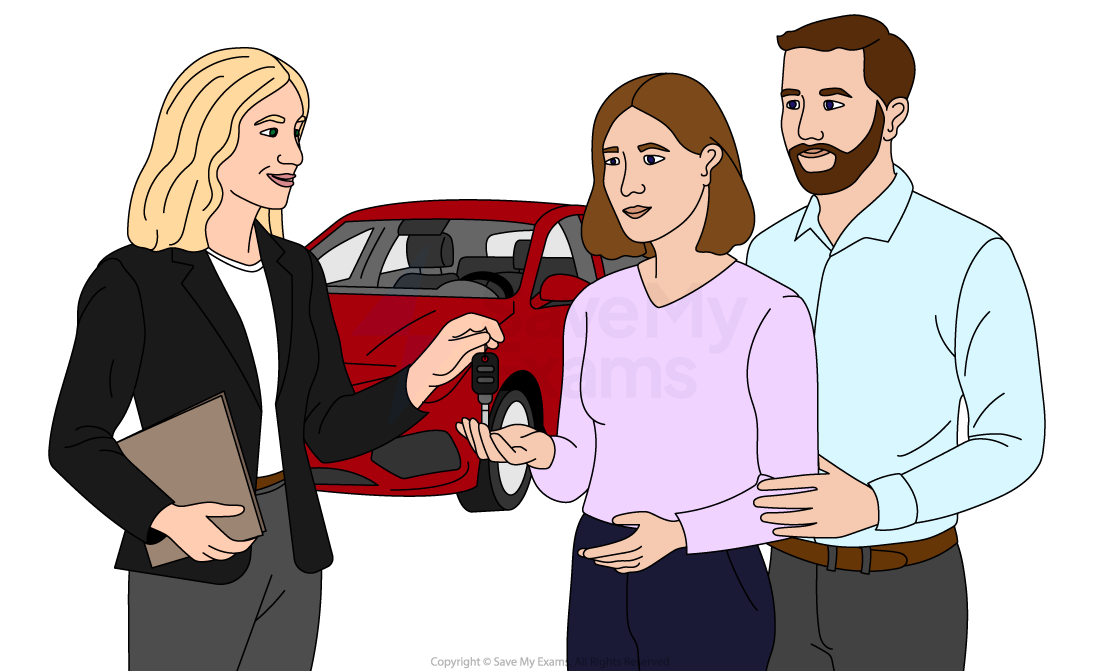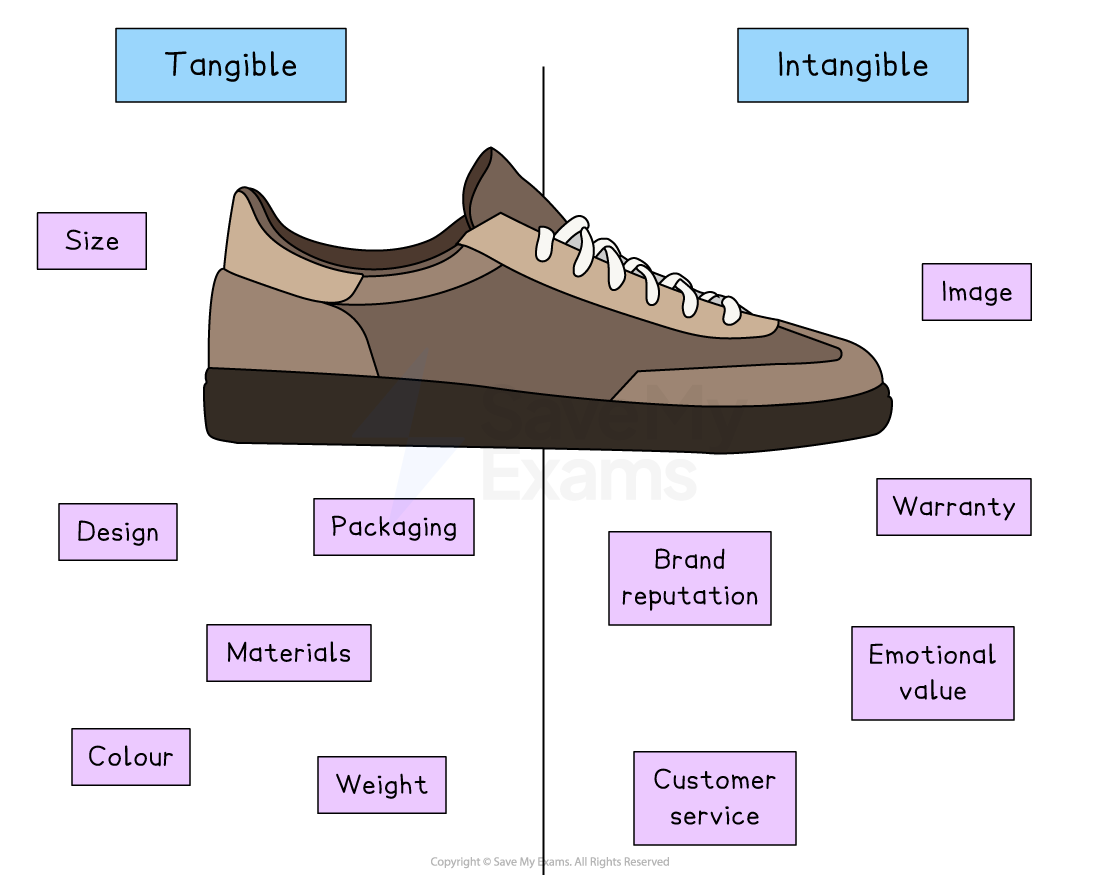Marketing Mix: Product (Cambridge (CIE) A Level Business): Revision Note
Exam code: 9609
Goods and services
Goods are physical, tangible items that can be touched, stored and owned
They are usually produced, then sold, and can be taken home or delivered
Examples include a loaf of bread, a car or a pair of shoes
Services are non-physical, intangible activities provided by people or businesses
They are usually performed at the time of purchase, and cannot be touched or stored
Examples include a haircut, a taxi ride or legal advice
In many situations, when a customer buys a product, they are also receiving a service as part of the overall experience
This is because businesses want to provide value beyond the physical item and improve customer satisfaction and loyalty
Case Study
Buying a new car – product and services combined

Priya and Henry decide to buy a brand-new electric car from a local dealership
The car itself is a tangible product, as it is a physical item they can see, test and drive away
However, their purchase also includes several services provided by the dealer to enhance their experience
Test drive and personalised advice
A salesperson offers Priya and Henry a free test drive and gives them advice on which model suits their needs based on their lifestyle and budget.
Finance and insurance assistance
The dealership helps them set up a car loan and offers optional car insurance plans
Free servicing for 12 months
As part of the deal, Priya and Henry receive a 12-month free servicing package, including checks and minor repairs
Home Delivery
Once the paperwork is complete, the car is delivered directly to their home
Customer support and warranty
They receive a 5-year warranty and access to customer support in case they need help with features or maintenance
Tangible and intangible product attributes
When a customer buys a product, they are influenced by both tangible and intangible attributes
These are the features that affect how the product looks, feels, performs or is experienced
Tangible and intangible attributes of a pair of trainers

Tangible attributes
These are the physical features of a product that can be touched, seen, or measured
They include things like size, colour, design, packaging, materials, and weight
Customers can compare tangible features before buying
E.g. When buying a pair of running shoes, the tangible attributes include the shape, colour, sole type, weight and material used
The customer can try them on and feel the comfort and fit
Intangible attributes
These are non-physical features that relate to the experience or perception of the product
They include things like brand reputation, warranty, customer service, image and emotional value
These features are often the reason a customer chooses one brand over another, even if the tangible features are similar
E.g. The same running shoes may come with a trusted brand name, a 12-month warranty, and a ‘satisfaction guarantee’
The buyer may also feel a sense of pride or motivation wearing a well-known performance brand
The importance of product development
Product development is the process of creating and launching new goods or services
It can help a business grow, stay competitive and meet changing customer needs
Without developing new products, a business risks becoming outdated or losing its market share
Why product development is important
Responding to changing customer needs
Customers’ tastes, preferences, and lifestyles change over time
Developing new products helps businesses stay relevant and meet these new demands
Staying ahead of competitors
By launching innovative or improved products, businesses can attract new customers and keep existing ones from switching to rivals
E.g. A tech company that releases a new smartphone with unique features may gain an advantage over competitors
Increasing sales and market share
New products can generate excitement, attract more attention, and increase overall sales
They may also open up opportunities to reach new market segments
Extending the product life cycle
As older products reach the end of their life cycle, new products can replace them and keep the brand fresh and active in the market
Taking advantage of new technology
Businesses can use advances in technology to improve performance, design, or sustainability, which can make their products more attractive
E.g. A home appliance company might develop smart, energy-efficient models to appeal to eco-conscious consumers
Costs of new product development
Cost | Explanation |
|---|---|
Market research collection and analysis can be time-consuming and expensive |
|
Investment in research, development, and design is often very costly |
|
The cost of producing trial products can be significant |
|
There may be low sales if the product does not meet market expectations |
|
A failed product can damage the brand and other products in the range |
|
Product differentiation
Differentiation is where a business distinguishes its products from those of competitors
This involves creating functions or features of the product (or firm) which help it to stand out from its competitors
Strong product differentiation helps the firm to develop its competitive advantage
Methods of differentiation
Successful business or product differentiation helps the business to increase demand for its products, increase brand loyalty, and allow the business to charge higher prices

Differentiation methods
Method | Explanation | Example |
|---|---|---|
Marketing and branding |
|
|
Packaging |
|
|
Functions and features |
|
|
Customisation |
|
|
Customer service |
|
|
Unique selling points
A unique selling point (USP) is a distinguishing factor or characteristic of a product, service or brand that sets it apart from its competitors
The USP helps a business to differentiate itself and give customers a reason to choose one product or service over others because it offers something distinct and valuable
There are a range of reasons why businesses develop a USP which can include
Developing a brand identity
Achieving a competitive advantage over rivals
Effective communication with customers
The attraction and retention of customers
Achieving power over pricing
Encouraging innovation and adaption
Reasons for developing a USP

Competitive advantage
A strong USP gives a business a competitive edge by creating a barrier to entry for other businesses in the market
If a business can offer something that is difficult to imitate, it becomes more difficult for competitors to gain customers
Brand identity
A unique selling point helps to shape the perception of the business in the minds of consumers
It becomes an essential part of the brand's story and message, which allows customers to associate specific qualities or benefits with the brand
Communication
A well-defined USP provides a clear message that highlights the unique benefits and advantages offered by the product, making it more memorable
E.g. Emirates' USP is a high-quality service and luxurious amenities supported by extensive marketing efforts such as sponsorship deals with sports teams and events
Retention and attraction of customers
A unique selling point can help attract new customers by appealing to their needs and desires, making customers more likely to choose and remain loyal to the brand
Pricing power
A strong USP can often justify the firms decision to charge higher prices for products, as customers are willing to pay more
This pricing power can improve a business's profitability and financial performance
E.g. Volvo has a reputation for safety, reliability and comfort, which means that customers are willing to pay premium prices for its vehicles
Innovation and adaptation
Developing and maintaining a unique selling point encourages businesses to continuously improve their products, explore new ideas and adapt to changing customer needs and preferences
E.g. Apple customers expect to be able to upgrade their technology devices frequently and value the ability to buy complementary goods, which add value

Unlock more, it's free!
Did this page help you?